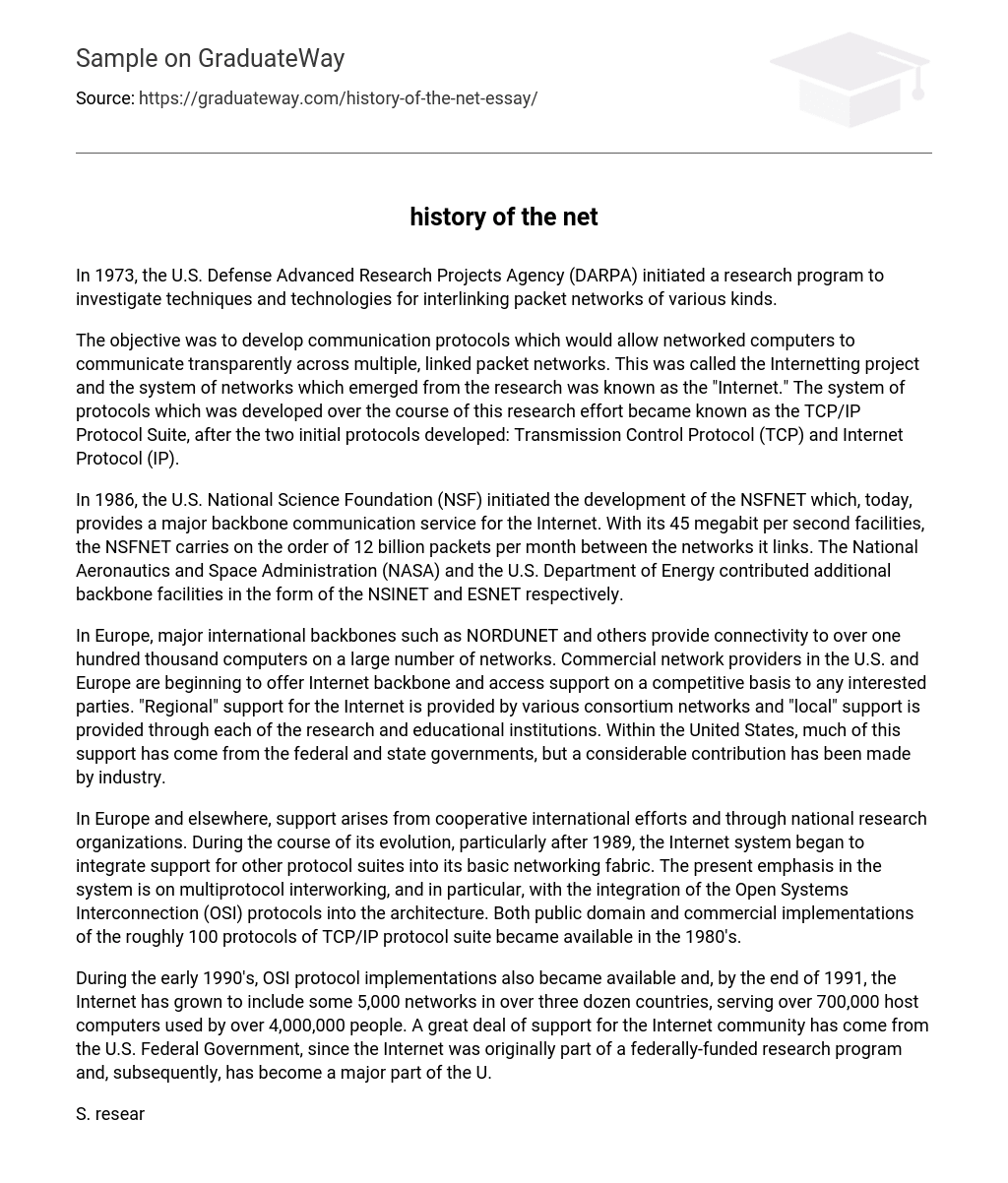The U.S. Defense Advanced Research Projects Agency (DARPA) initiated a research program in 1973 to explore methods and technologies for connecting different packet networks.
The objective was to develop communication protocols that would facilitate smooth communication between networked computers on various interconnected packet networks. This endeavor, referred to as Internetting, yielded the establishment of a networking system known as the “Internet.” The set of protocols generated during this research became recognized as the TCP/IP Protocol Suite and derived its name from the initial two protocols invented: Transmission Control Protocol (TCP) and Internet Protocol (IP).
The NSFNET, which was established by the U.S. National Science Foundation (NSF) in 1986, serves as a crucial communication service backbone for the Internet. It facilitates the transmission of around 12 billion packets per month at a rate of 45 megabits per second between interconnected networks. Additionally, NASA and the U.S. Department of Energy have established their own backbone facilities known as NSINET and ESNET respectively.
In Europe, NORDUNET and other major international backbones connect numerous computers across multiple networks. Commercial network providers in the U.S. and Europe offer competitive support for Internet backbone and access. Consortium networks provide “regional” support while research and educational institutions offer “local” support. In the United States, federal and state governments, along with industry, have made significant contributions to this support.
International collaborations and national research organizations provide support for Europe and other regions. The Internet system has resulted in the inclusion of extra protocol suites to offer support. Currently, there is a concentration on multiprotocol interworking, particularly incorporating OSI protocols into the architecture. In the 1980s, several implementations of approximately 100 protocols were introduced in the TCP/IP protocol suite, comprising both public domain and commercial versions.
By the late 1991, OSI protocol implementations allowed access to the Internet, which had grown to include around 5,000 networks in over thirty countries. These networks supported over 700,000 host computers utilized by more than 4,000,000 individuals. The U.S. Federal Government played a vital role in supporting the Internet community as it was initially funded through federal research and has since become an integral part of the U.S. infrastructure.
In the late 1980’s, the Internet user population and network constituents grew globally, including commercial facilities. Currently, the system primarily consists of private networking facilities situated in educational and research institutions, businesses, and government organizations worldwide.
The Coordinating Committee for Intercontinental Networks (CCIRN) has a crucial role in coordinating government-sponsored research networking plans. It was established by the U.S. Federal Networking Council (FNC) and the European Reseaux Associees pour la Recherche Europeenne (RARE). The CCIRN’s efforts have significantly encouraged international cooperation in the Internet environment.
Collaboration among different entities has been crucial for the existence of the Internet in the last fifteen years. The functioning of the system heavily relies on protocols that govern how its components work. Initially, these protocols were developed within the DARPA research program mentioned earlier. However, more recently, a wider range of organizations, with support from government agencies, industry, and academia across multiple countries, have taken on this responsibility. In 1983, the Internet Activities Board (IAB) was established to oversee the development of the TCP/IP Protocol Suite and provide research guidance to the Internet community.
The IAB has undergone multiple reorganizations and currently comprises two main components: the Internet Engineering Task Force (IETF) and the Internet Research Task Force (IRTF). The primary goal of these task forces is to collaborate with the IAB in developing and standardizing the TCP/IP protocol suite. They also aim to incorporate other protocols into the operations of the Internet.
The Internet Research Task Force, under the guidance of the Internet Activities Board and with support from government agencies, consistently organizes and explores innovative networking concepts. To manage the day-to-day activities of both the Internet Activities Board and Internet Engineering Task Force, a secretariat has been set up. Additionally, the Internet Engineering Task Force (IETF) conducts three plenary meetings each year. These gatherings involve around 50 working groups who communicate via email, teleconferencing, and in-person meetings during intervals.
The IAB regularly convenes through in-person meetings or videoconferences and communicates via telephone, email, and computer-mediated conferences. In addition, it has two important functions: publishing documents that describe the Internet and overseeing the allocation and recording of identifiers necessary for protocol operation. Throughout the evolution of the Internet, its protocols and other operational aspects were initially documented in Internet Experiment Notes and later in Requests for Comment (RFCs). Initially used to document the protocols of DARPA’s first packet-switching network, the ARPANET, established in 1969, RFCs have now become the primary source of information about the Internet.
The RFC editor currently handles the function of publishing. The Internet Assigned Numbers Authority (IANA) is in charge of recording identifiers, with a portion of this responsibility delegated to an Internet Registry. This registry acts as a central repository for Internet information and provides central allocation of network and autonomous system identifiers. In certain cases, subsidiary registries located in different countries are also given this task. Additionally, the Internet Registry (IR) centrally maintains the Domain Name System (DNS) root database. This database directs to distributed DNS servers that are replicated throughout the Internet. The DNS distributed database is utilized to associate host and network names with their internet addresses, playing a crucial role in higher-level TCP/IP protocols such as electronic mail.
The Internet is supported by multiple Network Information Centers (NICs) that offer users documentation, guidance, advice, and assistance. These NICs are crucial in serving the growing international community of Internet users. Initially, the user base was primarily composed of computer science and engineering professionals. However, the Internet now includes a wide range of fields such as sciences, arts, letters, business, military, and government administration.





